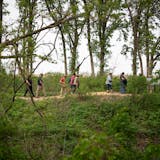WISCONSIN RAPIDS, Wis.
The battle began with a mother's anguished blog post about the death of her infant.
That was the catalyst for a hundred angry neighbors with undrinkable water who gathered at the Lake Aire Supper Club on a rainy September night to consider an extraordinary step: suing one of the biggest players in the state's powerful agriculture industry.
"These people can do anything they want," said Dan Matthews, a retired paper plant worker, describing the giant dairy operation that spreads tons of manure each year on the corn and potato fields around his community. "There's an injustice in that."
The Central Sands region in the green heart of Wisconsin is prized for its water: dozens of small, sandy-bottomed lakes, the Wisconsin River and hundreds of miles of trout streams.
But the region has also become a flash point in the fights over water erupting throughout the Upper Midwest. In a part of the country where there's always been more than enough water to go around for fishing, swimming, drinking and farming, how do you share it and protect it in the face of rising demand?
In central Wisconsin, the conflict is driven largely by the proliferation of giant irrigation rigs that arc over mile after mile of flat farm fields. They make this one of the nation's most productive farm states, with $88 billion a year in sales from food and food processing.
To many neighbors, however, they create an untenable drain on water that is tearing communities apart.
![Three weeks ago, Octavio Rodriguez switched from making transmission parts to casting parts for hospital bed brake assemblies at Twin City Die Castings. ] GLEN STUBBE • glen.stubbe@startribune.com Thursday, April 9, 2020 How employee-owned Twin City Die Casting, which just laid off 40 production workers of its 250 employees in what was supposed to be a good year, is trying to accelerate its pivot to growing medical parts business for ventilators, hospital beds, etc as it copes with instan](https://arc.stimg.co/startribunemedia/WNZYKGTZ5IYMUCO3KI5TR3N7WI.jpg?&w=80&ar=1:1&fit=crop)

djoles@startribune.com As boaters flock to Minnesota lakes and rivers this holiday weekend for the unofficial kick-off to the boating season, they'll face more inspections in and out of the water as local cities and counties ramp up their work to stop the spread of invasive species. Across the metro, more boat accesses will be staffed by watercraft inspectors thanks to $10 million funneled to county government programs this year, up from $4.5 million the state allocated last year. ORG XMIT: MIN1505222156290209 ORG XMIT: MIN1506021218440580](https://arc.stimg.co/startribunemedia/34QSKO44B2XKVNUZCO5SLJQSLY.jpg?&w=80&ar=1:1&fit=crop)
